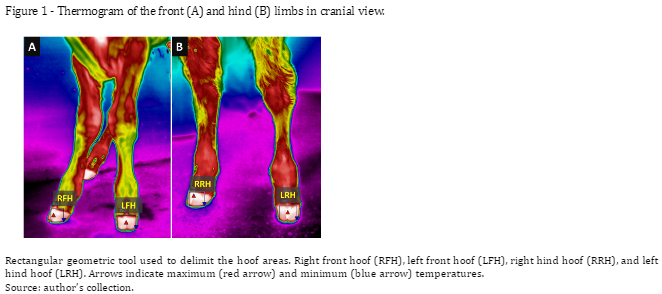Evaluation of body temperature by infrared thermography in calves under different thermal states
DOI:
https://doi.org/10.21708/avb.2024.18.2.12411Resumo
The first 30 days of calves' life is a critical period for dairy farming due to the incidence of diseases that can result in high rates of mortality and morbidity. Fever is an early clinical sign of illness; however, the use of a rectal thermometer to measure body temperature in large herds is impractical. Research using a thermographic camera has demonstrated the availability of obtaining the superficial temperature without contact the evaluated local. The objective of this study was to evaluate the use of infrared thermography to measure body temperature in calves ≤ 30 days old, identifying the body regions that present a high correlation between superficial infrared temperature (IRT) and rectal temperature. Nineteen Holstein calves were enrolled in this study. An infrared thermography camera was used to obtain thermographic images of the following body regions: hooves, eyes, forehead, muzzle, and mouth. Thermographic images were obtained at 3, 5, 10±2, 15±2 , 20±2, 25±2, and 30±2 days after birth. Maximum (Tmax), minimum (Tmin), and mean (Tmean) temperatures were obtained for each body region. Calves were categorized as hyperthermic or euthermic animals based on rectal temperature. Correlations between IRT and rectal temperature varied according to each body region and rectal temperature category. The maximum temperatures of left and right eyes measured by infrared thermography showed a higher correlation with rectal temperature, regardless of rectal temperature category (hyperthermia or euthermia). In general, Tmax and Tmean had a higher correlation with rectal temperatures than Tmin.
Downloads

Downloads
Publicado
Edição
Seção
Licença
Copyright (c) 2024 Acta Veterinaria Brasilica

Este trabalho está licenciado sob uma licença Creative Commons Attribution 4.0 International License.
Autores que publicam na Acta Veterinaria Brasilica concordam com os seguintes termos: a) Autores mantém os direitos autorais e concedem à revista o direito de primeira publicação, com o trabalho simultaneamente licenciado sob a Licença Creative Commons Attribution que permite o compartilhamento do trabalho com reconhecimento da autoria e publicação inicial nesta revista. b) Autores têm autorização para assumir contratos adicionais separadamente, para distribuição não-exclusiva da versão do trabalho publicada nesta revista (ex.: publicar em repositório institucional ou como capítulo de livro), com reconhecimento de autoria e publicação inicial nesta revista. c) Autores têm permissão e são estimulados a publicar e distribuir seu trabalho online (ex.: em repositórios institucionais ou na sua página pessoal) a qualquer ponto antes ou durante o processo editorial, já que isso pode gerar alterações produtivas, bem como aumentar o impacto e a citação do trabalho publicado (Veja O Efeito do Acesso Livre).


 Esta obra está licenciada com uma Licença
Esta obra está licenciada com uma Licença 